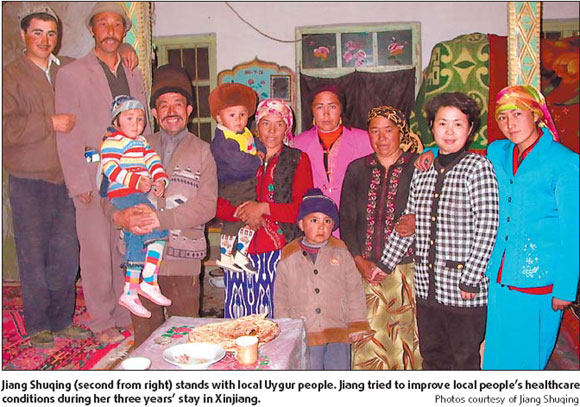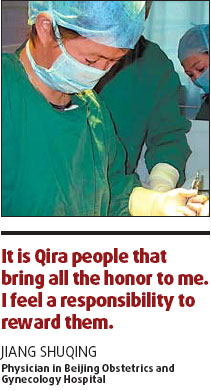Saving lives in a desert hospital built on sand

Jiang Shuqing, 50, spends most of her weekends attending medical seminars to catch up with the technological developments she missed during her three years at a medical aid mission in Northwest China's Xinjiang Uygur Autonomous Region.
"Three years are enough to make a doctor outdated," says Jiang, a chief physician in Beijing Obstetrics and Gynecology Hospital.
However, she believes she gained far more than what she lost during her time away. She received countless honors, such as being selected as a deputy to the upcoming 17th National People's Congress of the Communist Party of China (CPC).
Jiang says at the congress she will tackle the issue of medical workers' low wages.
In July of 2002, Jiang joined the medical aid team to Qira County, Hotan Prefecture of Xinjiang.
Qira is an impoverished county, in which the Uygur people account for about 98 percent of the population. It is surrounded by desert and is plagued by sandstorms.
Jiang thought she could handle working in the countryside, and was familiar with the hardship of rural labor. However, her heart sank when she faced the vast desert. "Sand was falling like rain onto the windows, and I could barely see anything," she says.
The next day, when she came to the county hospital, she saw a shabby one-storey building. The screen windows would not close, and flies flew around in the ward rooms.
During an operation, there was only simple sterilization, and the medical apparatus had rusted. The patients wore their own clothes to lie on the operation table. Without any heating in winter, locals had to light a stove.
On the fourth day, Jiang had to conduct an operation for a woman in critical condition.
"When it was all over, and the patient's condition was stable, I realized how risky it was. It was almost a miracle under the conditions of having no blood bank and facing a high risk of infection," she says.
Each time Jiang rescued a patient, the patient's relatives would bring her grapes and Chinese dates to express their gratitude.
She admitted that it was the heartfelt thanks from the patients she rescued from the brink of death that helped her get through the difficult life.

Although she faced language barriers with local colleagues and villagers, Jiang was active in participating in each activity of local families, such as marriages, funerals and baby celebrations.
"I never felt I was an outsider. In the parties, I danced and sang together with local people," she says.
Within three months, Jiang saw quite a few women with late stage cervical cancer, which she could do nothing about. The status of women's health there worried her, and she wanted to make it clear.
Back in Beijing, she sought help from her hospital and the Beijing Health Bureau, which provided 100,000 yuan ($13,300) and a set of health checkup facilities to support her project.
Within four months, Jiang's survey team reached nearly every corner of the county and completed health checkups for 8,020 married women. The results showed that 6,625 women had gynecological diseases of different degrees.
In particular, the rate of cervical cancer was as high as 526 per 100,000, which is 210 times the rate in Beijing. Forty-two women were checked with cervical cancer, and another 64 women had pre-cancer pathological changes.
Jiang believed that there were a whole range of reasons for the phenomena.
Poverty and the inconvenience of going to hospital made many women reluctant to see a doctor when they have developed minor diseases. Also, early marriage, early child delivery and poor sanitation could all play a role.
Raising money to help those poor cancer patients, particularly those with pre-cancer changes, stayed in Jiang's mind for quite a long time after she returned to Beijing.
This year, the photos and videos shot during her health survey in Qira County were exhibited in her hospital and attracted journalists and entrepreneurs, who were willing to help her establish a charity organization.
The charity already funded treatment for a Uygur woman in Qira this April. The money came from personal donations from Jiang's friends and colleagues.
For 27-year-old Tuohesutanhan, she could have had an early intervention treatment when she was checked with pre-cancer changes by Jiang in 2003. But she could not even afford the medical bills of only a few hundred yuan.
So, when Jiang found her this year, she already progressed to the cancer stage.
"It is a great pity. For patients of pre-cancer changes, the treatment is much cheaper and the rate of successful treatment is much higher compared to that of the cancer stage," says Jiang.
Jiang sees Qira County as her second home. "It is Qira people that bring all the honor to me. I feel a responsibility to reward them," she says.
"That is also a doctor's responsibility."
(China Daily 09/26/2007 page19)














